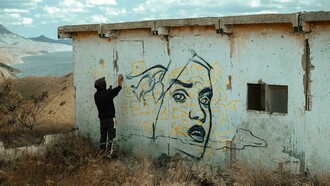Timeless sea breezes,
sea-wind of the night:
you come for no one.(Rainer Maria Rilke)
Oh, we do like to be beside the seaside. The smell of salt and sun lotion, the feel of warm sand between the toes, the taste of melting ice cream - so many memories of childhood. Most of all, the many shades of blue, the hues and sounds of the ocean soothing, calming, healing.
From sunrise to sunset, with or without boats, with children playing and ladies promenading, the encounter of land and water is a continuous source of inspiration for artists. Painters throughout the ages tried to capture the scintillating light on the water, the changing colours and the moving horizon.
Maritime art, the depiction of sea and seagoing vessels is as ancient as man’s desire to conquer the seas. Petroglyphs depicting primitive boats date back 40,000 years. The subject of ocean waters has created a rich heritage of myths, legends, and poetry that speak of fear and fascination. In contrast, the beach spells pleasure, joy, and occasionally sweet melancholy.
Like many good things, it is said the Victorians invented the holiday by the seaside, although rich people had enjoyed seaside breaks since the 1700s. The Romans, of course, vacationed in style in their villas by the sea. With the development of the railway, seaside holidays became available to more people; both fun (for the children) and beneficial (for the frail) a sojourn beside the sea was an event to look forward to for the rest of the year.
Painters on the beach
The design of the beach, the convergence of sand and water, is an invitation to walk along with it and painters often introduced the walkers into the landscape. The elegant promenade, an iconographic genre best known for a horseback ride in the woods and urban settings, soon reached the cliffs and beaches. Well-dressed figures, mainly ladies, strolling along the seashore provided an interesting contrast with the extensive calm of the sea and sky.
The scene in Monet’s controversial Trouville paintings was originally considered rather unremarkable; on one side the elegant hotels with sea views, on the other side the golden sand, the three-tone water, and lots of skies. Between the two, summarily sketched figures, ladies in white dresses like the sea foam, holding white parasols, promenading on and off the boardwalk, an 1870’s fashion parade. Monet spent several weeks in Trouville that summer with his wife and young son. The painting of his wife Camille and a friend reading on the beach resembles a holiday snapshot, the emphasis more on the balance of the composition than on detail. Bold brushstrokes of white convey the brilliance of the sun.
Paintings of beach and seaside resorts were popular with other contemporary artists like Degas, Manet, and Boudin. In Degas’ Beach Scene, a woman combs the hair of a girl who, although fully dressed, has apparently been swimming, as her swimsuit is drying nearby. Other people in the background have been swimming too, and are leaving the scene wrapped in towels. The influence of Japanese prints much admired by Degas is evident here, in the choice of subject (women combing each other’s hair) as well as the treatment of the figures and the objects on the beach.
Sunlight and its reflection in water bring a sense of well-being and, at the end of the 19th century, it brought a variant of Impressionism called Luminism. As the name indicates, Luminism was concerned with the representation of light on the canvas – a subject that has preoccupied many artists since the Renaissance.
One of the painters best placed (and not only geographically) to convey light is Joaquín Sorolla. The women in his painting, his wife and daughter, stroll along a sun-drenched beach wearing white dresses, clutching a white parasol, holding on to their wide sunhats. There is a strong breeze on this Valencian beach. The white veils are flying at an angle parallel to their shadows, parallel to the line where the water meets the sand, perhaps. The effect of dappled sunlight is mesmerising.
From a trip to the Mediterranean, Henry Scott Tuke brought a palette of blues and gold. His depiction of nude adolescent boys bathing in the cool waters of the Cornish seashore has recently enjoyed a revival. Between sand and water, Tuke’s glistening figures are hesitating between manhood and childhood play.
The beach may invite us to leisurely stroll, but also play, chase, and run. Carefree young girls and naked children frolic in the shallow water and along with it. There is light, there is joy.
The great playground
Among the Impressionists, Mary Cassatt may be the one who best knew how to represent children. Her painting of two toddlers playing on the beach is full of tenderness. The little girls sit on the sand, close but turning away from each other, each preoccupied with her own task. A range of blues dominates the picture - the pale blue of the sea in the background, the deep royal blue of the dress and shoes. In the foreground, the yellow sunhat with a bright red ribbon is surrounded by muted tones of sand and water. Light bounces off the white dresses and the sails on the horizon.
Picasso’s statuesque women are oblivious of their state of semi-undress and apparently of each other, although they are holding hands, as they run across a beach. One is looking up at the sky, the other is looking towards the sea. Both women are portrayed with strong and tanned bodies, their hair blowing in the breeze, painted against a bright blue background.
The confluence of sky and sea is liberating and joy-inducing. Wish you were here.















